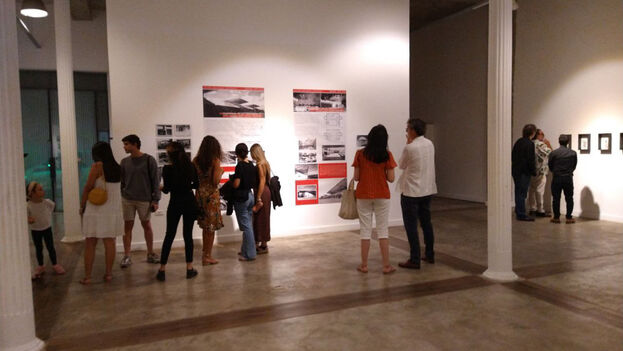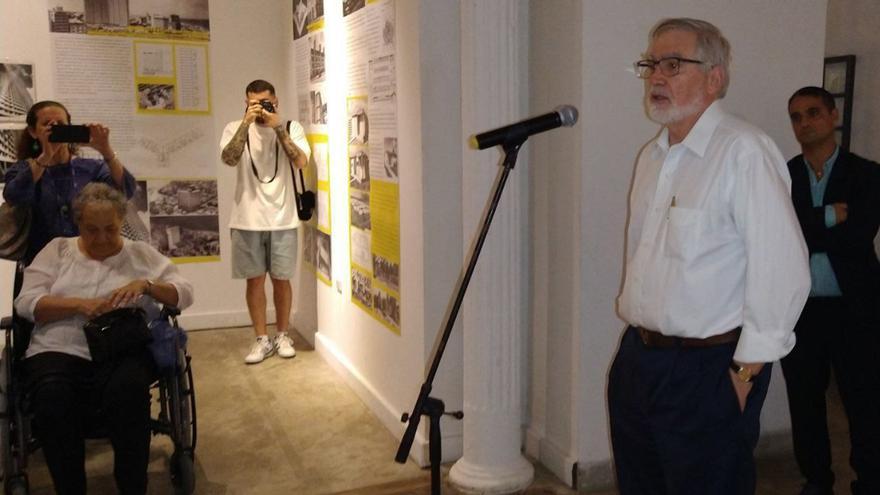
![]() 14ymedio, Reinaldo Escobar, Havana, 6 December 2022 — An exhibition entitled Martín Domínguez El exilio otro [the Other Exile], inaugurated at the Taller Gorría Gallery in Old Havana on December 5 (coincidentally, the Day of the Builder in Cuba), did justice to the Spanish architect Martín Domínguez Esteban (1897-1970) who was behind works as important as the Focsa building, Radiocentro (today the Yara cinema and headquarters of the Cuban Institute of Radio and Television), the current Ministry of Communications, the Marianao City Hall and numerous homes.
14ymedio, Reinaldo Escobar, Havana, 6 December 2022 — An exhibition entitled Martín Domínguez El exilio otro [the Other Exile], inaugurated at the Taller Gorría Gallery in Old Havana on December 5 (coincidentally, the Day of the Builder in Cuba), did justice to the Spanish architect Martín Domínguez Esteban (1897-1970) who was behind works as important as the Focsa building, Radiocentro (today the Yara cinema and headquarters of the Cuban Institute of Radio and Television), the current Ministry of Communications, the Marianao City Hall and numerous homes.
We say that he “was behind” because his name did not appear as a signing architect but as “treasurer” or “decorator” and this was because Domínguez never managed to have his professional title revalidated in Cuba.
He escaped from Francoist Spain where he had been “purged for life” for his role in building the military defenses of the Republican side of Madrid in 1936. He arrived in Havana, by the way, in January 1937 and stayed in this city for more than a quarter of a century.
Despite the burden of not being able to show a recognized title, many used his services, including former president Ramón Grau San Martín, who entrusted him with his summer residence in Varadero.

At the beginning of the Revolution, he participated in the construction of popular houses promoted by the National Institute of Savings and Housing. His reputation led him to the office of Commander Ernesto Guevara, who openly asked him for his political position. His son relates that Domínguez replied that he felt conservative in regards to the private family and liberal in politics. “We’re doing badly, Galician,” said the Argentine, and that same day he decided to leave Cuba.
He collected what he could carry in his car and put it on the ferry that still offered trips between Havana and Miami. He was in that city for a very short time because he decided to settle in New York.
Still in Miami, his son, a clever boy with the same name and who has also followed a career as an architect, was probing him to find out how that adventure would end. And this was the unforgettable response he received: “We are never going to return to Cuba. We are not going to have the exiles’ crick in the neck, like the Spaniards who said ’in two months we will be back in Madrid’. We are not going back to Cuba, we must look ahead and rebuild.”
And he didn’t come back. He died in New York in September 1970 at the age of 72 knowing that wherever he went he left a lasting and useful mark. His work is studied today on the subject of Modern Cuban Architecture. This exhibition, which will be open to the public until December 12, pays tribute to him and fills an unacceptable gap in the memory of Cubans.
____________
COLLABORATE WITH OUR WORK: The 14ymedio team is committed to practicing serious journalism that reflects Cuba’s reality in all its depth. Thank you for joining us on this long journey. We invite you to continue supporting us by becoming a member of 14ymedio now. Together we can continue transforming journalism in Cuba.
